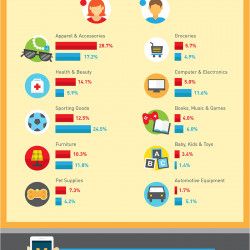Mobile commerce today and tomorrow – infographic
The mobile commerce market, or m-commerce for short, continues to flourish. In the US, the number of mobile consumers is already 80 million. In Poland, m-commerce is not yet as developed as in the West, but the phenomenon exists and is still growing – refer to the report "Mobile commerce in Poland".
The Demac Media blog has an interesting infographic showing facts about both the US and global m-commerce market – we bring you the most relevant and interesting of this information.
99% of the world's population are subscribers
By the end of this year, the global population is expected to be 7.6 billion people. According to Demac Media, as many as 7.5 billion will be mobile subscribers – that's almost 99% of the population! It's hard to believe, but this is the information provided by the infographic.
The number of mobile devices in use will far outstrip the number of subscribers, reaching 10 billion.
Mobile advertising market continues to grow
The popularity of the m-commerce and m-marketing market continues to grow. Mobile ads are currently being clicked on by 1202 people per minute. Amounts invested in mobile advertising are changing – as recently as 2012, only 2.4% was invested in mobile advertising, while 22.5% was invested in digital advertising. In 2022, the figures are 26.8% and 6.2%, respectively. According to forecasts, in two years the mobile advertising market will already have 11% invested in mobile advertising, compared to 29.2% in digital advertising.
These numbers speak for themselves.
Apps vs. mobile sites
For many companies, websites or mobile are still a more popular solution than apps, but that may soon change. As it turns out, as many as 89% of mobile purchases are made from apps rather than websites. Only 11% of consumers make purchases on mobile sites.
Key first impressions
User experience when using apps is key. As many as 52% of consumers are unlikely to use a store's offer again if they encounter an unpleasant surprise at least once regarding the use of an app. Unfortunately, as many as 84% of users have negative experiences with m-commerce.
40% of users will use a competitor's offer after such an experience. Page performance has a huge impact on conversion – slow loading times cause 97% of visitors to abandon a site. Average loading time is 7 seconds.
If this time is extended to 10 seconds, the site will leave as much as 37% of visitors.
Smartphones vs. tablets
In the US, the ratio of smartphone owners to tablet owners is 60% to 40%. Despite this, almost twice as much time is spent by users shopping with tablets as with smartphones. By 2017, the amount of money we spend via smartphones will double, and in terms of tablets – increase by as much as four times. So in the m-commerce category, tablets are definitely winning – their conversion rate is 600% higher than smartphones and 60% higher than computers.
On average, the value of orders made on tablets is 17% higher than on smartphones.
M-commerce will account for 1/3 of all e-commerce
According to forecasts, the m-commerce market in 2017 is expected to account for as much as 31% of all online marketing – in 2013 it was 14%. Its value will then be $109 billion.
Today, more than half of users aged 25-54 put shopping second in terms of online activities. They are right behind the use of social media. Smartphones increasingly accompany us in shopping, not only online.
As many as 8 out of 10 people in 2012 used their phone while shopping in a stationary store. We use them primarily to check product reviews, compare prices or find a nearby stationary store.
13 times more mobile data and the fashion for wearables
The amount of data transferred on mobile between 2013 and 2018 will increase as much as 13 times. Not only will the number of data transfers increase, but also sales of smartphones, tablets and – most importantly – wearables. It is estimated that more than 30 billion wearables will be sold by 2018, with smartwatches leading the way among them.
Not only stores
It is also worth remembering that e-commerce is not just about merchants and stores. More than 80% of insurers plan to implement mobile systems to improve customer service and sales. The second industry that is booming in m-commerce is banking. More than half – as many as 6 in 10 – of bank customers switch banks because of the quality of mobile service.
It is estimated that as many as 100 million users will be using mobile banking by 2017.
